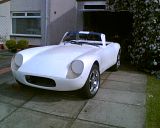Can anyone help regarding throttle pots. I am using the hotwire setup but with home made plenum fitted with a BMW throttle body, when I connect the BMW throttle pot up to the hotwire the voltage does not move up and down with the pedal. If I disconnect the signal wire from the hotwire (BMW throttle pot) and leave the feed and earth the signal moves from 0.2 up to 4.6volts ok with the pedal. I have noticed that some pots are 5000 ohm and 10000 ohm do you think this could be the problem and if so how do you test to see which is which?
Thanks George
Throttle Pots
Moderator: phpBB2 - Administrators
Make a note of which wires take the voltage feed and ground into the throttle pot then disconnect them. Now measure the resistance across those two wires into the throttle pot, for hotwire it should be 5000 ohms.
Now measure the resistance between the signal wire and the ground wire, this should start off low resistance (100ohms ish) and then increase as you open the throttle to a max of 5000 ohms.
If that works OK the throttle pot should drive the ECU fine. If not then you need to check at the ECU plug. Disconnect it and look for the above conditions on;
Pin 25- Sensor ground(Note not normal engine ground)
Pin 3- Reference voltage feed.
Pin 20- Throttle pot signal.
jw
Now measure the resistance between the signal wire and the ground wire, this should start off low resistance (100ohms ish) and then increase as you open the throttle to a max of 5000 ohms.
If that works OK the throttle pot should drive the ECU fine. If not then you need to check at the ECU plug. Disconnect it and look for the above conditions on;
Pin 25- Sensor ground(Note not normal engine ground)
Pin 3- Reference voltage feed.
Pin 20- Throttle pot signal.
jw




